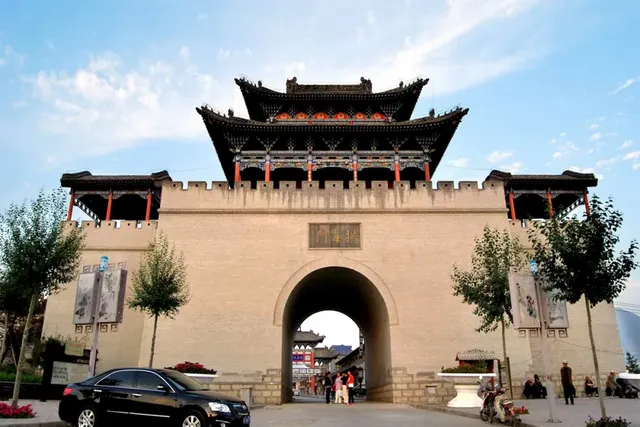Huangyuan in Qinghai - Dangar Old Town Travelogue41
We finished our driving tour of Qinghai Lake and drove to the ancient city of Dangar in Huangyuan County, Qinghai, which is located about 40 kilometres from Xining, on the northern bank of the Yellow River and the shore of the Western Sea. According to historical records, the ancient city of Dangar is Qiang land, Loess Plateau and Qinghai-Tibet Plateau in the combination here, farming culture and grassland culture in here, Tangfan ancient road and Silk Road South in here through, many ethnic groups in here gathered, since the Western Han Dynasty, here gradually become commercial, military, religious, folklore and another multi-cultural blend of the town, known as the "sea and Tibetan throat It has been known as the "throat of the sea and Tibet", the "tea and horse-trading capital" and the "Little Beijing".
The arch sea gate is the western city gate of Dangal ancient city, the breeze will not be passed on the city tower bell "tinkling" sound
.webp)
Huangyuan Dangar Old Town is located in Huangyuan County, Qinghai Province, at the source of the Huangshui River, 40 km from Xining City. Known as the "sea and Tibet throat", "tea and horse merchants capital" "," small Beijing "of beauty. Dangal, that is, the Tibetan "Dongkor" of the Mongolian translation, meaning "white conch". The Loess Plateau and the Tibetan Plateau are combined here, the farming culture and the grassland culture meet here, the ancient Tangfan Road and the South Silk Road are crossed here, and many ethnic groups gather here.
.webp)
The street lamps along the street are decorated with antique lantern signs, a traditional local craft that originated in the middle of the Qing Dynasty and has been around for more than 200 years, making it one of the wonders of China's intangible cultural heritage.
.webp)
The City God Temple, built in 1776, has a history of 230 years.
.webp)
The temple was built during the Qianlong period of the Ming Dynasty, covering an area of more than four acres, with a three-room gate, stone steps in front of the gate, stone lions and flag piers surrounding the pole Diao Dou, and a brick wall opposite the gate, two feet high and three feet wide, carved with floral patterns, pictured here is the ancient theatre in the temple
.webp)
Pailou of Miaohuatianbao (partial)
.webp)
The old Ming and Qing dynasty streets of the old city of Dangal are pleasant places to stroll around, with few tourists and no hustle and bustle of hawkers.
.webp)
The sculpture in the old street - "Jousting"
.webp)
The Dangal Performance Theatre is located just north of the pagoda, where performances are held regularly every day.
.webp)
The Gandhi pagoda, I think there may have been a Guandi temple here in the past
.webp)
One of the surviving foreign companies in Dangal Old Town - the British-run Renji Trading Company, which is a historical testimony of foreign business in Huangyuan in the old China
.webp)
The historic Ming and Qing dynasty street pagodas
.webp)
With a history of more than 600 years, the ancient city of Dangal exudes a cultural glow and historical charm, the brick and tile, a door and window can let us travel back in time to imagine the prosperity and glory of the past.
.webp)
Since the Western Han Dynasty, Dangar has been a major trading area, with the Tang Dynasty and the Tubo setting up the first "tea and horse market" on the Qinghai-Tibet Plateau under the Moon Mountain today. By the thirteenth year of the Republic of China (1924), commercial trade had reached its peak, with merchants gathering in the city and trade flourishing. The old city of Dangal was also known as the "commercial capital around the sea" and the "Little Beijing".
.webp)
The pagoda at the entrance of the lane adds to the charm of the old city
.webp)
Zhenhai Xieyong In the third year of the Daoguang reign (1823), the Dangal camp was upgraded to Zhenhai Xieyong due to military needs, which shows its importance in terms of military location and that it was truly a "military town".
.webp)
Dagger Office, located opposite to Renji Trading Company, Qianlong nine years (1744), because Danggar Road to Tibet, close to Qinghai, for the Han, Tu, Hui, Tibet, Mongolian trading places, by the Xining Road Commander Yang Ying Ju to request the court to Gautam County, the chief book to move, and special permission "all transactions, all in Dancing, no other leak". During the Daoguang years, because Huangyuan sea and Tibetan trade, Chinese and foreign throat, specially set up Dangar Hall, belongs to the Xining Province
.webp)
Dangal Office is the administrative authority of the old city of Dangal and the office of the officials
.webp)
The Temple of Literature in the middle of Old Street
.webp)
The beautiful relief carving of Confucius travelling around the world outside the Temple of Literature
.webp)
The Dacheng Hall is part of the Temple of Confucius
.webp)
The urn tower of the Yingchun Gate
.webp)
Green bricks, grey tiles, vermilion colonnades, painted in seven colours ...... Time travel, like being in the Ming and Qing dynasties, watching the clothes fluttering, walking at ease, looking at the old shops, and being overwhelmed by the sight

That originated in the middle of the Qing Dynasty.
The City God Temple, built in 1776, has a history of 230 years.